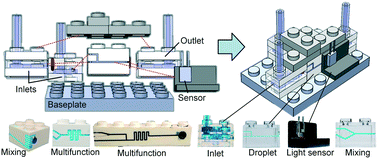Our official English website, www.x-mol.net, welcomes your feedback! (Note: you will need to create a separate account there.)
High-precision modular microfluidics by micromilling of interlocking injection-molded blocks†
Lab on a Chip ( IF 6.1 ) Pub Date : 2017-12-12 00:00:00 , DOI: 10.1039/c7lc00951h Crystal E. Owens 1, 2, 3, 4 , A. John Hart 1, 2, 3, 4
Lab on a Chip ( IF 6.1 ) Pub Date : 2017-12-12 00:00:00 , DOI: 10.1039/c7lc00951h Crystal E. Owens 1, 2, 3, 4 , A. John Hart 1, 2, 3, 4
Affiliation

|
Wider use and adaptation of microfluidics is hindered by the infrastructure, knowledge, and time required to build prototype systems, especially when multiple fluid operations and measurements are required. As a result, 3D printing of microfluidics is attracting interest, yet cannot readily achieve the feature size, smoothness, and optical transparency needed for many standard microfluidic systems. Herein we present a new approach to the design and construction of high-precision modular microfluidics, using standard injection-molded blocks that are modified using micromilling and assembled via elastically averaged contacts. Desktop micromilling achieves channel dimensions as small as 50 μm depth and 150 μm width and adhesive films seal channels to allow internal fluid pressure of >400 kPa. Elastically averaged connections between bricks result in a mechanical locating repeatability of ∼1 μm, enabling fluid to pass between bricks via an O-ring seal with >99.9% reliability. We demonstrated and tested block-based systems for generating droplets at rates above 9000 min−1 and COV <3%, and integrated optical sensors. We also show how blocks can be used to build easily reconfigurable interfaces with glass microfluidic devices and imaging hardware. Microfluidic bricks fabricated by FDM and SLA 3D printing cannot achieve the dimensional quality of molded bricks, yet 3D printing allows customized bricks to be integrated with standard LEGOs. Our approach enables a wide variety of modular microfluidic units to be built using a widely available, cost-effective platform, encouraging use in both research and education.
中文翻译:

通过对联锁的注塑成型块进行微铣削而获得的高精度模块化微流体†
微流体的广泛使用和适应性受到构建原型系统所需的基础设施,知识和时间的阻碍,特别是在需要进行多种流体操作和测量的情况下。结果,微流体的3D打印引起了人们的兴趣,但不能轻易实现许多标准微流体系统所需的特征尺寸,平滑度和光学透明度。本文中,我们介绍了一种使用标准注射成型模块设计和构建高精度模块化微流体的新方法,该模块通过微铣削进行修改并通过弹性平均接触。台式微铣削可实现深度仅为50μm,宽度为150μm的通道尺寸,并且粘合剂薄膜可密封通道,以允许内部流体压力> 400 kPa。砖之间弹性均连接导致的〜1微米的机械定位重复性,使流体砖之间通过经由O形环密封件具有> 99.9%的可靠性。我们演示并测试了基于块的系统,该系统以高于9000 min -1的速率生成液滴和COV <3%,以及集成的光学传感器。我们还展示了如何使用块来与玻璃微流体设备和成像硬件建立易于重新配置的接口。通过FDM和SLA 3D打印制造的微流体砖无法达到模制砖的尺寸质量,但是3D打印允许将定制的砖与标准LEGO集成在一起。我们的方法可以使用广泛可用的,具有成本效益的平台来构建各种模块化微流控单元,从而鼓励在研究和教育中使用。
更新日期:2017-12-12
中文翻译:

通过对联锁的注塑成型块进行微铣削而获得的高精度模块化微流体†
微流体的广泛使用和适应性受到构建原型系统所需的基础设施,知识和时间的阻碍,特别是在需要进行多种流体操作和测量的情况下。结果,微流体的3D打印引起了人们的兴趣,但不能轻易实现许多标准微流体系统所需的特征尺寸,平滑度和光学透明度。本文中,我们介绍了一种使用标准注射成型模块设计和构建高精度模块化微流体的新方法,该模块通过微铣削进行修改并通过弹性平均接触。台式微铣削可实现深度仅为50μm,宽度为150μm的通道尺寸,并且粘合剂薄膜可密封通道,以允许内部流体压力> 400 kPa。砖之间弹性均连接导致的〜1微米的机械定位重复性,使流体砖之间通过经由O形环密封件具有> 99.9%的可靠性。我们演示并测试了基于块的系统,该系统以高于9000 min -1的速率生成液滴和COV <3%,以及集成的光学传感器。我们还展示了如何使用块来与玻璃微流体设备和成像硬件建立易于重新配置的接口。通过FDM和SLA 3D打印制造的微流体砖无法达到模制砖的尺寸质量,但是3D打印允许将定制的砖与标准LEGO集成在一起。我们的方法可以使用广泛可用的,具有成本效益的平台来构建各种模块化微流控单元,从而鼓励在研究和教育中使用。



























 京公网安备 11010802027423号
京公网安备 11010802027423号